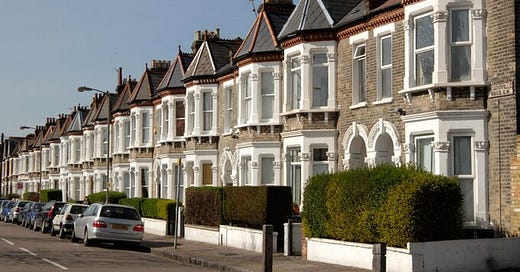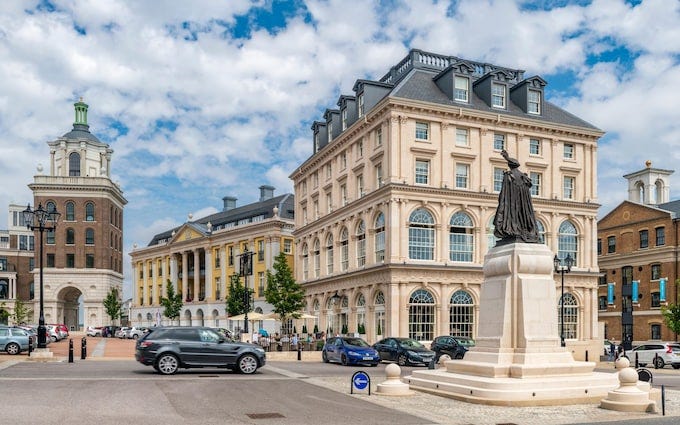£33bn: The Economic Benefits of Building the Homes Britain Needs
And a £18.7bn windfall for the Chancellor ahead of the Budget
Both Labour and the Conservatives are committed to iron-clad fiscal rules designed to get debt falling as a share of GDP over five years. Effectively, there are three ways for any Chancellor to fund their priorities, whether it’s green investments or tax cuts, while bringing debt down. That’s cutting spending, raising taxes, or growing the economy. While cutting spending or raising taxes are deeply unpopular, growing the economy is clearly what we should be aiming for.
One of the easiest ways to achieve economic growth and to increase the Chancellor’s fiscal headroom is to build the homes Britain needs.
New modelling from Britain Remade has demonstrated that building homes in the right areas could generate £18.7bn that the Chancellor could use for their priorities, based on delivering the 442,000 homes a year the Centre for Cities says Britain needs to close our housing shortage.
There’s the immediate fiscal benefits of stamp duty sales providing a one-off boost to the Exchequer. Plus there’s the direct impact on the economy of more activity in the construction sector putting people to work.
Yet, we don’t build houses for housebuilding’s sake. We build them because they meet a need. More homes would bring down prices and make housing more affordable.
This would have two big impacts on how much money Jeremy Hunt, or Rachel Reeves, has to play with:
More homes means lower rents, which in turn means less taxpayer’s money going directly to landlords in the form of housing benefit. Already the UK spends more on housing benefit as a percentage of GDP (1.4%) than any other OECD member, and it costs more than running any government department (£23.4bn).
More significantly in the long run, more homes pushes down rents and makes it easier for people to move to where the best paying jobs are, allowing them to be more productive. Plus building more homes in our most productive areas allows for agglomeration effects, where novel ideas are shared and connections are made, which are the foundations for innovation.
Recent research from the Centre for Cities estimates that the UK has a housing shortage of around 4.3 million homes, which haven’t been built as a result of Britain’s onerous planning system. This would take at least half a century to close at the Government's current 300,000 homes a year target (leaving aside the fact that we haven’t built 300,000 homes in a year since the 1960s). The Centre for Cities estimates we need to build 442,000 homes per year to close the housing shortage within 25 years.
For the sake of calculating the impact of more homes on the public finances, this analysis makes the following assumptions:
It estimates the average construction cost of new housing, using the average home size of 105 sq metres and the build cost per sq metre of £2,700.
Houses would only be built in local authorities where the cost of housing is greater than the cost of building housing (which indicates that there is a housing shortfall).
It allocates the new 442,000 homes proportionally by the difference between house prices and the cost of building. Local authorities that have the highest ratio between house prices and the cost of building would build more homes, because those are the areas where price signals suggest the housing shortage is the highest.
There are other taxes associated with new development, e.g. Section 106 levies/Community Infrastructure Levies, and Council Tax, but this analysis assumes that these go towards funding government services that are provided to these new developments, resulting in a neutral position for the national government’s balance sheet.
Since new housing decreases the sale prices of homes, the model adjusts the sale price of the new homes to reflect the elasticity of house prices in accordance with the Redfern Review. For every 1% increase in the number of dwellings, house prices fall by 1.8%. The model then calculates the new house price for the area along with the stamp duty paid (assuming 39% of buyers are first time buyers).
By building 442,000 homes in places where Britain’s housing crisis is most impacted, the Exchequer could raise £4bn in stamp duty. This is a one off raise, although it would likely increase the amount of stamp duty paid in the coming years as well considering that there would be more homes on which stamp duty could be levied.
Since building more houses decreases the cost of housing, we would expect that the cost of housing benefit paid out would also fall. The total existing value of homes across the UK is £8.4tn, with building 442,000 new homes, the overall decrease in the costs of housing is estimated to be 4.7% (once again using the elasticity from the Redfern Review). A 4.7% decrease in the value of housing benefit costs, would save the Exchequer £1.1bn a year.
Building more housing in the right areas increases economic growth in several ways. The most obvious is that the building of new homes means jobs for builders and more spending on building supplies. The Home Builders Federation estimates that 1.5 construction jobs and 0.9 supply chain jobs are created for every house built. If we built 442,000 homes, compared to the 212,000 that were built last year, we’d expect there to be an additional 552,000 jobs created. At average salaries, this would mean an increase in GDP by £19.5bn.
Secondly, high house prices mean that people have less money that they could spend on other things. This means both less consumption of goods and services, which helps the economy, and less money that can be put into productive investments, which will impact the rate of growth in the long term. The 4.7% fall in house prices would save private renters £2.8bn a year in lower rents. They can then spend this on goods, services, and investments, improving economic growth.
Thirdly, the higher prices of housing in our most productive areas means that many people are priced out of the areas completely, so that they can’t move within reach of better jobs. Wages in London, for example, are 15% higher than the national average, but once you factor in the higher housing costs, the average Londoner is only 1% better off. Many people are better off staying where they are rather than moving to cities where they can earn a higher wage. This harms the people priced out of productive cities, while also harming city dwellers who can’t combine their skills with the skills of people who are priced out. The Housing Theory of Everything describes this as:
“many businesses end up leaving highly skilled staff without assistance, spending their time on work that could be done by others, lowering the time they can spend on the tasks they’re best at. This happens in people’s private lives too: people often spend hours trying to fix their leaky pipes instead of just calling in a plumber, because the prices of plumbers near them have risen to cover the costs for plumbers to live there.”
The model uses the average salary in each local authority and compares it to the average salary in the UK. Since most of the housebuilding will be in areas where the average salary is higher than the national average, people will be able to improve their salary by moving to the area. This works out to be £8.2bn of additional income (and GDP), assuming there are two earners per household.
Finally, there are the intangible benefits of agglomeration. With more people living in Britain’s most productive areas, there will be more chance meetings at networking events, in cafes and pubs, and in offices. These chance meetings can lead to big new ideas being shared and new innovations that boost growth. Whilst agglomeration effects have been challenging to measure, it is not unreasonable to assume that the increase in size of our cities, and the new ideas and innovation that would occur, would generate upwards of £2.5bn of additional national income. Even a 1% growth in London’s GDP would increase GDP by £5bn, so this is a conservative estimate.
In total therefore, building 442,000 homes in the UK could raise GDP by £33.1bn. At current tax receipts as a percentage of GDP of 41.1%, economic growth alone would generate £13.6bn in increased government revenue.
Taking together the stamp duty increases, the fall in housing benefit costs, and the increased tax revenue from economic growth, building 442,000 homes in Britain would give the chancellor a £18.7bn boost ahead of the upcoming budget.
While still substantial, the benefit to the Treasury drops to £13.1bn if we built the 300,000 homes that both the Conservatives and Labour have set as a target. Stamp duty would raise £3.1bn with a £766m saving in housing benefit costs. The economy would grow by £22.5 billion - handing the Treasury a further £9.2 billion in tax receipts.
Instead of trying to cut a shrinking pie in different ways, we should focus on growing the pie. Britain Remade has just launched our Get London Building manifesto, which would deliver 900,000 homes in London over 15 years ahead. Building more housing is the best way to grow the economy, increase fiscal headroom, and deliver the priorities of the winner of the next general election.






